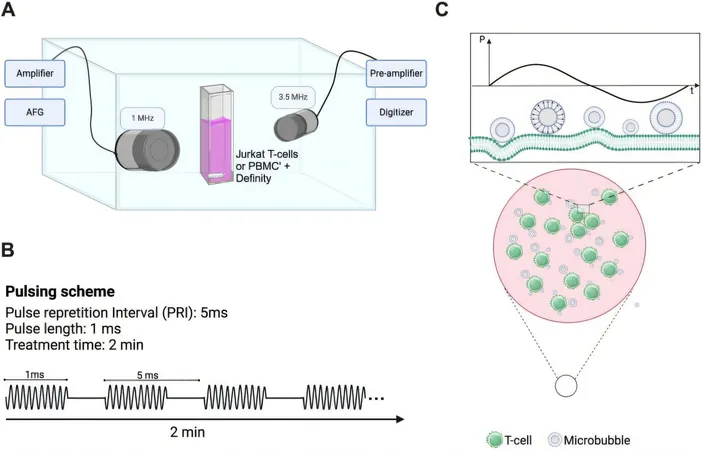
Revolutionary Ultrasound-Guided Microbubbles: A Game Changer in Cancer Immunotherapy!
2025-01-15
Author: Siti
Overview
In a groundbreaking study from Concordia University, researchers have unveiled a pioneering technique to combat cancer tumors using ultrasound-directed microbubbles! This innovative approach not only enhances the efficacy of the immune response but also utilizes technology that is already widely employed in medical imaging and drug delivery.
Research Details
Published in the journal *Frontiers in Immunology*, the research team, comprising experts from the Biology and Physics departments, aimed to enhance the function of T cells—the body’s natural warriors against cancer. By adjusting the behavior of these immune cells through ultrasound, they dramatically increased their permeability, allowing them to release over 90 types of cytokines—crucial signaling molecules integral for a robust immune response against tumors.
Methodology
The methodology involves targeting freshly isolated human immune cells with focused ultrasound beams in conjunction with clinically approved contrast agent microbubbles. When these microbubbles resonate under the influence of ultrasound, they create a vibration effect that effectively mimics the T cell's natural response to antigens, prompting the secretion of essential signaling proteins. Notably, this process occurs without any damage to the T cells, representing a significant leap forward in cancer therapies.
Expert Insights
Brandon Helfield, associate professor of biology and physics and the study's supervising author, explained, "We’re merging ultrasound and microbubbles with cancer immunotherapy, empowering our immune cells to combat cancer effectively." This dual-action strategy specifically targets the persistent challenge posed by tumors that deactivate T cells and hinder them from producing crucial cytokines when infiltrating tumor environments.
Significance of Findings
Ana Baez, the lead author of the paper and a Ph.D. candidate, emphasized that “the microbubbles can reactivate cells that have been suppressed within the tumor.” This rejuvenation allows T cells to produce vital proteins which can pave the way for the generation of more immune and blood cells, leading to a beneficial feedback cycle in the immune response.
Observations
Interestingly, the study observed that cytokine secretion is time-dependent, showing an increase of up to 3.6 times after 48 hours compared to untreated cells. However, the researchers also noted that higher cell membrane permeability occasionally led to a decrease in cytokine release, indicating a complex interplay needing further investigation.
Future Implications
The implications of this research extend far beyond initial lab results. Helfield, who also holds the Tier II Canada Research Chair in Molecular Biophysics in Human Health, pointed out that the techniques using microbubbles are already clinically applied for imaging purposes. In the not-so-distant future, researchers envision adapting this technology not just for diagnostics but for therapeutic uses as well, allowing for highly localized activation of T cells where needed.
Additional Opportunities
Moreover, researchers are optimistic about the potential for integrating cancer-fighting drugs into these treatments, amplifying their effectiveness. This approach is entirely non-invasive, granting the possibility of repeated applications without risk of harm to patients.
Conclusion
As the world seeks more effective cancer treatments, this research could herald a new era in immunotherapy, characterized by techniques that harness and enhance the natural power of the body’s immune system. Stay tuned for more exciting developments in this field!

 Brasil (PT)
Brasil (PT)
 Canada (EN)
Canada (EN)
 Chile (ES)
Chile (ES)
 Česko (CS)
Česko (CS)
 대한민국 (KO)
대한민국 (KO)
 España (ES)
España (ES)
 France (FR)
France (FR)
 Hong Kong (EN)
Hong Kong (EN)
 Italia (IT)
Italia (IT)
 日本 (JA)
日本 (JA)
 Magyarország (HU)
Magyarország (HU)
 Norge (NO)
Norge (NO)
 Polska (PL)
Polska (PL)
 Schweiz (DE)
Schweiz (DE)
 Singapore (EN)
Singapore (EN)
 Sverige (SV)
Sverige (SV)
 Suomi (FI)
Suomi (FI)
 Türkiye (TR)
Türkiye (TR)
 الإمارات العربية المتحدة (AR)
الإمارات العربية المتحدة (AR)